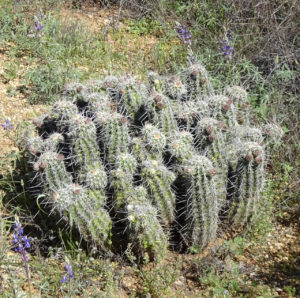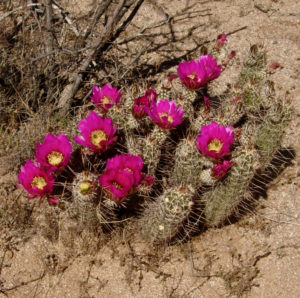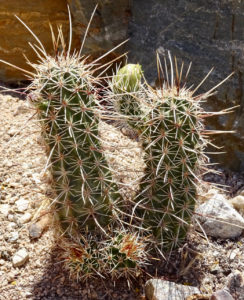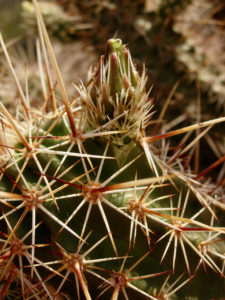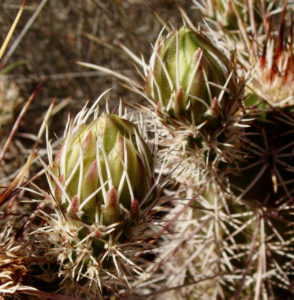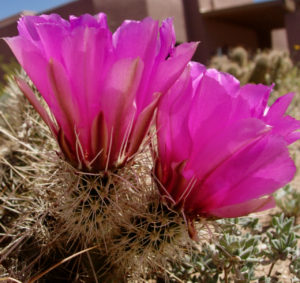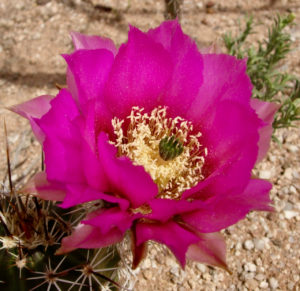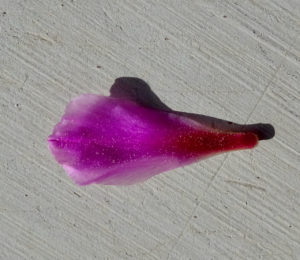Hedgehog Cactus
Echinocereus fasciculatus
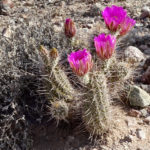
About the Plant
The hedgehog cactus are among the first cactus to bloom in spring, often in a race with the earliest prickly pears to see which opens its flowers first. The most common hedgehog in our area is often called strawberry, pinkflower, or robust hedgehog. A well-established plant will have multiple stems clumped together, often spreading more than a foot wide. The rose-pink to magenta flowers open late March into April. This cactus is widespread around Tucson, especially to the south and southeast of the city.
Strawberry hedgehog cactus grow best in full sun but cannot tolerate poorly-drained soil. Water newly planted hedgehogs until established - 2 weeks after planting then every 1 (summer) to 3 (winter) weeks. Plants original to your landscape or in the ground for two years usually need no supplemental water. Do not put these cactus on irrigation.
In general, hedgehog cactus are easily dug and transplanted. For more information, see the Tucson Cactus and Succulent Society brochure (this is a trifold brochure: start reading on the 2nd page).
Notes:
- There is much confusion around the scientific name of this plant. Flora of North America (Volume 4, published 2003) lists it as Echinocereus fasciculatus. The 2017 publication Field Guide to Cacti and Other Succulents of Arizona, published by the Tucson Cactus and Succulent Society lists it as Echinocereus engelmannii subspecies fasciculatus. It has also been placed in the species Echinocereus fenderi. No formal morphological or molecular studies have so far been conducted that might clarify this issue.
- All cactus, including strawberry hedgehog, are salvage restricted in Arizona. A permit is required for removal of this plant (basic info from Arizona Department of Agriculture; AZ Code-see pages 41-51 ).
Wildlife value: attracts bees and small insects.
More Information
Weekly Plant on strawberry hedgehog cactus
Map of distribution in US as Echinocereus fasciculatus
In books:
Field Guide to Cacti and Other Succulents of Arizona by Breslin, et al., page 86 (as Echinocereus engelmannii ssp. fasciculatus)
ID Characteristics
Along each rib are areoles, special structures that hold the spines of the cactus. The areoles of strawberry hedgehog cactus are spaced about 1/2 inch apart. Often there is one long spine, 2 inches in length, protruding straight out from the center of each areole, though sometimes there are 1 or 2 additional, shorter central spines. Eight to twelve short spines (1/4 - 3/4 inch long) protrude out horizontally all around the edge of the areole. Each spine has broad zones of different colors - white, yellowish, brown, grey, or black. The spines are round in cross-section, not flattened in any way and not hooked.
Cactus flowers have an unusual structure. When the cactus begins to flower, a specialized stem starts to grow just above an areole, often breaking through the skin of the cactus (you can see this in the close-up photo of the spines, above). You know it is a stem because it has areoles and spines and in some cactus, even small leaves. This stem is called the flower tube. The sepals, petals, stamens, style, and stigma of the flower are all on top of this flower tube. However, the ovary, where the seeds will form, is below all those structures and is embedded in the flower tube. The flower tube of strawberry hedgehog cactus is about 1 inch long and 1/2 - 3/4 inch wide.
The numerous sepals and petals of hedgehog cactus are similar and, because of this, are grouped together under the name of tepal. The inner tepals are rose-pink to magenta. The outer tepals are somewhat shorter and have less color. All tepals have darkened midribs, more noticeable on the outer tepals.
The open flower is 2 - 2.5 inches in diameter. There are many yellow stamen with yellow anthers (click on the photo to enlarge to see the yellow pollen on the tepals). In the center of the flower is the green stigma, with its many fingers.
The highly colored, inner tepals are narrow at the base and wide at the tip, nearly an inch wide. They are between 1.5 and 2 inches long. The small, shiny, yellow dots on the tepal in the photo is pollen.
After the flower fades, the fruit matures inside the flower tube, which most people will consider the "fruit". This "fruit" is orange-red to red, about an inch long and almost as wide. The seeds are black or dark reddish brown.
